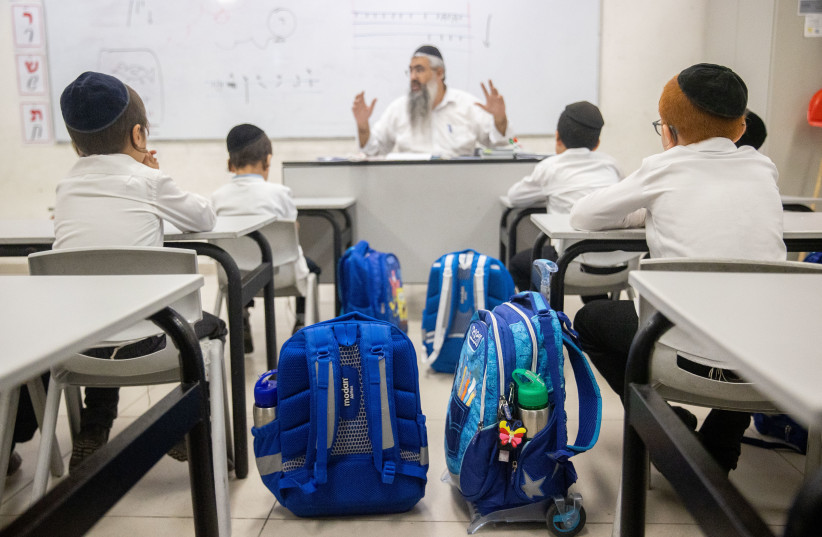Israel’s education system is a ‘ticking time bomb’
A new report has shown that 50% of Israel's students are getting a third-world education.

Ultra orthodox jewish kids seen the first day of
school at an Ultra-Orthodox school in Neve Yaakov Neighborhood of
Jerusalem on August 9, 2021.
Some 50% of Israeli children from the country’s fastest-growing sectors are getting a third-world education
that will not be able to support a first-world economy, without which
there will be no first-world health, welfare and defense systems,
according to a new report published by the Shoresh Institution for Socioeconomic Research.
“The
absence of a first-world ability to defend itself in the world’s most
violent region will jeopardize the State of Israel’s very existence,”
Prof. Dan Ben-David, who authored the 2021 report, told The Jerusalem Post. “This is an existential threat.”
Israel
has enjoyed one of the world’s highest fertility rates for quite some
time. The most recent report shows that Israeli families have an average
of 3.1 children – a minimum of an entire child more than any other OECD
country.
Families
in Mexico and Turkey have an average of 2.1 children. The rest of the
countries in the list average between one and 1.9.

Students and parents protest outside the Municipality in Tzfat after
their school was closed allegedly due to safety deficiencies. August 25,
2021
However,
those children are being born mostly into certain sectors: Haredi
(ultra-Orthodox) and Arab Israeli students each make up more than
one-fifth of Israel’s first graders today, about 43% in total.
Most
haredi students do not even study the core curriculum. The average
score of Arab Israelis in the basic subjects is far below the entire
developed world.
The education provided to students in Israel’s social and geographical peripheries is often inadequate as well.
That’s about 50% of students, and it “turns the national education picture into a ticking time bomb,” Ben-David said.
The
COVID-19 pandemic highlighted the fundamental problems of the education
system, bringing to the forefront challenges that had existed for years
prior, despite continual investment.
The Education Ministry budget is larger even than that of the Defense Ministry, yet students are simply not making the grade.
Israeli
children’s average level of knowledge in mathematics, science and
reading is below that of every developed country, the Shoresh report
showed. Educational gaps in primary education within Israel are also
much higher. And the country has more students who do not reach the
minimum level of knowledge set by the OECD – even without considering most ultra-Orthodox children, who do not study the materials and therefore do not participate in international exams.
Israel’s
non-religious Jewish schools rank below a third of the developed
countries, when looking at the most recent average achievement scores in
25 OECD countries and in Israel on the Program for International
Student Assessment (PISA) exam, which evaluates what students know in
reading, mathematics and science and what they can do with that
knowledge.
The
country’s religious schools fall below 80% of those countries. Arab
Israelis fall at the very bottom, including beneath nine of the 10
Muslim countries that participated in the most recent PISA exam.
While
Israel cannot be compared to the United States in terms of population
size, the US, like Israel, can be divided into four major ethnic groups.
In the US, PISA scores show, Asians and whites are getting a better
education than every student in every developed country, achieving an
average score of 549 on the exam.
Israel’s non-religious students average 509. Israel’s religious students average 485.
However,
American Hispanics achieve only 470, while African Americans have
almost the lowest score – 436. But there is one group that achieves
lower: Arab Israelis achieve an average of 372.
Moreover,
Israel has the highest percentage (33%) of students in any OECD country
scoring at or below “level 1” in mathematics, science and reading on
the PISA exam, on which one is the lowest score and six is the highest.
“If
education is a jumping-off board to the marketplace, with these gaps in
knowledge, you cannot expect equality in future generations,” Ben-David
said.

Israelis return to school amid coronavirus concerns, September 1, 2020
So, why is this happening?
THE
EDUCATION system likes to blame the country’s large classrooms as the
reason children are struggling to learn. But according to the Shoresh
report, while this may be a contributing factor, not all Israeli
classrooms are large, and there is no explanation for why efforts have
not been made to reduce class size given the number of teachers that
Israel employs per student – higher than average.
The
number of students per teacher in Israeli elementary schools is nearly
identical to OECD averages, according to the report, and the middle and
high schools have fewer children per teacher than the OECD average.
Additionally, the number of instruction hours in Israel is greater than in most OECD countries.
As such, Ben-David pointed to a different challenge: the quality of Israeli teachers.
He
said that the knowledge levels of undergraduate Israeli education
students are very low – both compared to other Israeli college and
university students and when compared to others in the developed world.
Some
79% of Israelis study to be teachers in one of the country’s teaching
colleges, another 17% learn in general colleges and 4% are students in
regular universities. The average psychometric score for those studying
in teaching colleges is nearly 25% lower than the average for Israeli
university students, the score is almost one-third (32%) lower for those
who are accepted to general colleges, and still 9% lower even for those
who learn to teach at the university level.
The
situation becomes even more acute when looking at how Israeli teachers
rank on the OECD’s Program for the International Assessment of Adult
Competencies (PIAAC) test, which examines the basic knowledge and skills
of adults ages 16-64. Israeli literary teachers’ skills are close to
the bottom of the developed world, and the knowledge of Israel’s math
teachers is the lowest among developed countries.
Ben-David
stressed that this situation is not because teachers in Israel are
underpaid. He said that “contrary to Israeli conventional wisdom, the
country’s teachers’ salaries are higher than the national average salary
and are also higher than average teachers’ salaries in developed
countries.”
Specifically,
Israeli elementary school teachers make 3% more than the average
received by their OECD counterparts, middle school teachers 16% more,
and high-school teachers 23% more when looking at what teachers make per
hour of instruction.
“Israel
regards brain power as its primary natural resource. Its hi-tech sector
– nearly the only economic sector that’s thriving economically in the
global arena – does not have nearly the number of workers with
university-level educations that it needs. How can teachers who could
not even get accepted to universities themselves educate children at a
level that could bring them there?” Ben-David asked. “How can we expect
our kids to reach university and be a part of modern society if their
teachers are not at that level?”
As Israel goes back to school on September 1, rethinking its classroom models to keep kids safe from coronavirus,
Ben-David said there is an equally urgent need to reimagine the way
that Israel chooses, trains and compensates its educational staff.
“The system is not functioning well,” he stressed. “We need an overhaul of the entire system.”
While
the sky is unlikely to fall this year or next, Ben-David told the Post
that if Israel does not act soon, there will be “a point of no return.”
He
highlighted the situation in Beirut that was brought on in large part
by demographics – a less fertile, more educated elite sector of society
was overturned over time by a more fertile, less-educated poor
population.
“It is
hard for young people today to imagine that Beirut was once called the
Paris of the Middle East,” Ben-David said. “Today, it is a poverty state
at the brink of explosion.... Countries do fail.”
To
ensure that Israel is equally a success story in 2065 as it is today,
Ben-David said that when it comes to education, “Israel must get its act
together while we still can.”


